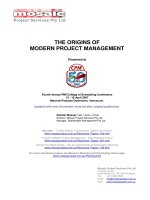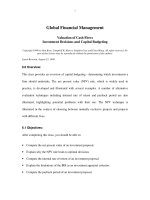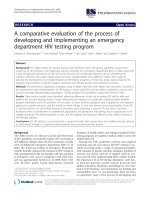Lecture no33 process of developing project cash flows
Bạn đang xem bản rút gọn của tài liệu. Xem và tải ngay bản đầy đủ của tài liệu tại đây (1.2 MB, 20 trang )
Process of Developing Project Cash Flows
Lecture No.33
Chapter 10
Contemporary Engineering Economics
Copyright © 2016
th
Contemporary Engineering Economics, 6 edition
Park
Copyright © 2016 by Pearson Education, Inc.
All Rights Reserved
Chapter Opening Story
Eclipse has spent $1.4 billion to develop its six-seat 550 twin engine jet.
o Base price: $2,895,000
o Fuel efficiency: 59 gallons per hour
o Flying range: 430 miles
o Operating cost: $648 per hour
o Demand: unknown
At Issue: How would you determine the cash flows from this jet investment?
th
Contemporary Engineering Economics, 6 edition
Park
Copyright © 2016 by Pearson Education, Inc.
All Rights Reserved
Key Elements of Investment Decision
th
Contemporary Engineering Economics, 6 edition
Park
Copyright © 2016 by Pearson Education, Inc.
All Rights Reserved
Types of Cash Flow Elements in Project Analysis
th
Contemporary Engineering Economics, 6 edition
Park
Copyright © 2016 by Pearson Education, Inc.
All Rights Reserved
Example 10.1: When Projects Require Only Operating and Investing
Activities
Given: Financial Data
o Investment: $125,000
o Project life: 5 years
o Salvage value: $50,000
o Annual labor savings: $100,000
o Annual manufacturing costs
o Labor: $20,000
o Materials:$12,000
o Overhead:$8,000
o Depreciation method: 7-year MACRS
o Income tax rate: 40%
o MARR: 15%
Find: Determine the project cash flows
th
Contemporary Engineering Economics, 6 edition
Park
Copyright © 2016 by Pearson Education, Inc.
All Rights Reserved
Solution
th
Contemporary Engineering Economics, 6 edition
Park
Copyright © 2016 by Pearson Education, Inc.
All Rights Reserved
Return on Invested Capital
The firm earns a 27.62% return on funds that remain internally invested
in the project.
n=0
Beginning
n =1
n=2
n=3
n=4
n=5
−$125,000
−$116,380
−$100,279
−$83,231
−$63,974
−$34,525
−$32,144
−$27,697
−$22,988
−$17,670
$81,619
Balance
Return on
Investment
(27.62%)
Payment
−$125,000
$43,145
$48,245
$44,745
$42,245
Project
−$125,000
−$116,380
−$100,279
−$83,231
−$63,974
Balance
th
Contemporary Engineering Economics, 6 edition
Park
Copyright © 2016 by Pearson Education, Inc.
All Rights Reserved
≈0
When Projects Require Working-Capital Investments
What is Working Capital?
Working Capital Equations
Accounting definition:
The amount carried in cash, accounts
receivable, and inventory that is available
to meet day-to-day operating needs.
WC = Current Asset – Current Liabilities
∆WC = ∆CA - ∆CL
where ∆WC = changes in working capital
How to treat working capital investments:
∆CA = changes in current assets
just like a capital expenditure except that
∆CL = changes in current liabilities
no depreciation is allowed.
If ∆WC > 0, working capital requirement. With the net change being
positive, the firm has a net requirement of working capital that has
to be financed during the year. Therefore, the WC requirement
appears as uses of cash in the cash flow statement.
If ∆WC < 0, working capital release. If this amount were negative,
there would have been a cash inflow from working capital release,
which could add to the sources of cash.
th
Contemporary Engineering Economics, 6 edition
Park
Copyright © 2016 by Pearson Education, Inc.
All Rights Reserved
When Projects Require Working-Capital Investments
What is working capital?
Definition: The amount carried in cash,
accounts receivable, and inventory that is
available to meet day-to-day operating needs.
How to treat working capital investments
Just like a capital expenditure except that no
depreciation is allowed
Working Capital Equations
oAccounting definition
WC = Current Asset −
Current Liabilities
ΔWC = ΔCA − ΔCL
where ΔWC = changes in
working capital
ΔCA = changes in current
assets
ΔCL = changes in current
liabilities
oIf ΔWC > 0, working capital
requirement.
oIf ΔWC < 0, working capital
release.
th
Contemporary Engineering Economics, 6 edition
Park
Copyright © 2016 by Pearson Education, Inc.
All Rights Reserved
Example 10.2: Working Capital Requirements
Given: Elements of Working Capital
Find: Working capital requirement
th
Contemporary Engineering Economics, 6 edition
Park
Copyright © 2016 by Pearson Education, Inc.
All Rights Reserved
Solution
th
Contemporary Engineering Economics, 6 edition
Park
Copyright © 2016 by Pearson Education, Inc.
All Rights Reserved
Example 10.3: Cash Flow Statement with Working Capital
th
Contemporary Engineering Economics, 6 edition
Park
Copyright © 2016 by Pearson Education, Inc.
All Rights Reserved
Changes in Profitability
Changes in Profitability
o
NPW without the Working
Capital Requirement
PW(15%) = $43,152
o
NPW with the Working
Capital Requirement
PW(15%) = $31,420
Difference: $11,732
(lost earnings due to funds
tied up in working capital)
th
Contemporary Engineering Economics, 6 edition
Park
Copyright © 2016 by Pearson Education, Inc.
All Rights Reserved
When Projects Results in Negative Taxable Income
Negative taxable income (project
Regular
loss) means you can reduce your
Project
Business
Combined
Operation
taxable income from regular business
operation by the amount of loss,
which results in a tax savings.
Taxable
$100M
(10M)
$90M
$35M
?
$31.5M
income
Income
taxes
(35%)
Tax savings
Tax Savings = $35M − $31.5M
= $3.5M
Or (10M)(0.35) = −$3.5M
th
Contemporary Engineering Economics, 6 edition
Park
Copyright © 2016 by Pearson Education, Inc.
All Rights Reserved
Example 10.5: Project Cash Flows for a Cost-Only Project
Project Nature: Installing a cooling-fan at Alcoa Aluminum’s McCook plant to reduce the
work-in-process inventory buildup
Given: Financial facts
o Required investment: $536,000
o Service life: 16 years
o Salvage value: 0
o Reduction of WIP (working-capital release): $2,121,000
o Depreciation Method: 7-year MACRS
o Annual electricity cost: $86,000
o Income tax rate:40%
o MARR: 20%
Find: Develop the project cash flow
th
Contemporary Engineering Economics, 6 edition
Park
Copyright © 2016 by Pearson Education, Inc.
All Rights Reserved
Cash Flow Statement
th
Contemporary Engineering Economics, 6 edition
Park
Copyright © 2016 by Pearson Education, Inc.
All Rights Reserved
Analysis
o
o
o
PW(20%) = $991,008
o
o
RIC = 241.87% >20%
i* = 4.24% and 291.56%
A nonsimple and mixed
investment
Good investment
th
Contemporary Engineering Economics, 6 edition
Park
Copyright © 2016 by Pearson Education, Inc.
All Rights Reserved
When Projects Are Financed with Borrowed Funds
• Key issue: Interest payment is a tax-deductible
• What about principal payments?
• As the amount of borrowing is NOT viewed as
expense.
• What needs to be done
• Once a loan repayment schedule is known,
separate the interest payments from the
income to the borrower, the repayments of
principal are NOT viewed as expenses either—
NO tax effect.
annual installments.
th
Contemporary Engineering Economics, 6 edition
Park
Copyright © 2016 by Pearson Education, Inc.
All Rights Reserved
Example 10.4: Loan Repayment Schedule
o
o
o
Amount financed: $62,500, or 50% of total capital expenditure
Financing rate: 10% per year
Annual installment: $16,487 or, A = $62,500(A/P, 10%, 5)
End of
Beginning
Year
Balance
Interest Payment
Principal Payment
Ending
Balance
1
$62,500
$6,250
$10,237
$52,263
2
52,263
5,226
11,261
41,002
3
41,002
4,100
12,387
28,615
4
28,615
2,861
13,626
14,989
5
14,989
1,499
14,988
0
$16,487
th
Contemporary Engineering Economics, 6 edition
Park
Copyright © 2016 by Pearson Education, Inc.
All Rights Reserved
Solution
Effects of debt financing on
profitability
o
o
MARR = 15%, debt interest rate = 10%
NPW without debt financing (100% equity)
PW(15%) = $31,420
o
NPW with debt financing (50% debt)
PW(15%) = $44,439
o
The debt financing increases the present worth by
$13,019. This result is largely caused by the firm’s
being able to borrow the funds at a cheaper rate
(10%) than its MARR of 15%.
th
Contemporary Engineering Economics, 6 edition
Park
Copyright © 2016 by Pearson Education, Inc.
All Rights Reserved









